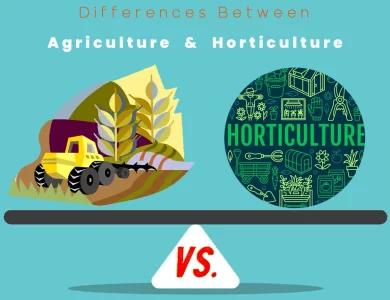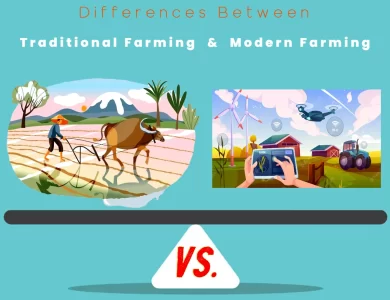Agriculture
Exploring the World of Agriculture: Unraveling Differences in Terms and Other Items
Welcome to our comprehensive category page dedicated to uncovering the intriguing realm of agriculture. Here, we delve into the fascinating world of farming, cultivation, and everything in between. In this particular section, we will take you on a journey to explore the differences in terms and other items related to agriculture. So, grab a cup of coffee, sit back, and prepare to expand your knowledge!
-

Khadar vs Bhangar
Bhangar and Khadar soils, two prominent soil types in India's vast plains, differ significantly in origin, characteristics, and agricultural relevance. Bhangar soils, older and coarser, are primarily found in the northern plains of India. They exhibit a darker hue, owing to their mineral-rich content, and generally offer good natural drainage. These soils are versatile, accommodating a range of crops, including wheat, barley, and oilseeds. However, their nutrient content may vary, often necessitating supplementary fertilization. Bhangar soils contribute to stable vegetation, assisting in erosion prevention and groundwater recharge. In contrast, Khadar soils are relatively younger, formed through annual alluvial deposition along riverbanks and low-lying areas. They possess a finer texture, appearing lighter in color, and have superior water retention capabilities. Khadar soils are renowned for their fertility, making them ideal for water-intensive crops like paddy rice, sugarcane, and vegetables. The annual replenishment of nutrient-rich sediments during floods ensures consistently high fertility. Khadar soils also play a crucial role in supporting biodiversity and river ecosystems. The choice between Bhangar and Khadar soils depends on various factors, including crop preferences, access to irrigation, and ecological objectives. Understanding these soil types' nuances is pivotal for sustainable land use and conservation efforts in the diverse agricultural landscapes of India.
-

Intensive Farming vs Subsistence Farming
In the world of agriculture, two prominent farming methods, subsistence farming and intensive farming, stand as polar opposites in terms of goals, practices, and impacts. Subsistence farming is rooted in self-sufficiency and revolves around producing just enough to meet the needs of the farmer's family and local community. This approach often thrives on smaller-scale operations, diverse crop cultivation, and sustainable, traditional farming practices. The primary objective of subsistence farming is to ensure food security for the immediate household, relying on local resources and minimal external inputs. On the other hand, intensive farming operates on a grander scale, driven by profit and commercial agriculture. It involves large-scale production, advanced technologies, and the cultivation of high-yield crop varieties. Intensive farming is designed to generate surpluses of agricultural products that can be distributed in local, national, or even international markets. This approach requires significant capital investment, access to modern machinery, and a focus on maximizing yields to meet market demands. The differences between these two farming methods extend beyond scale and goals. They encompass crop diversity, environmental impact, labor intensity, economic considerations, and sustainability practices. While subsistence farming leans towards traditional, eco-friendly practices, intensive farming is characterized by its modern, profit-driven approach. Exploring these disparities provides valuable insights into the dynamic world of agriculture and its impact on food production, communities, and the environment.
-

Horticulture vs Agriculture
Agriculture and horticulture, while both involving the cultivation of plants, are distinct fields with unique characteristics and contributions. Agriculture, with its broad scope, focuses on large-scale production of various crops, including staple foods like wheat and rice. In contrast, horticulture specializes in the cultivation of fruits, vegetables, herbs, flowers, and ornamental plants, with an emphasis on quality and diversity. The differences extend to their methods; agriculture often relies on modern machinery and synthetic chemicals for efficiency, while horticulture embraces sustainable and organic practices. These distinctions also manifest in their environmental impact, with agriculture occasionally having a more substantial footprint due to its scale. Despite these disparities, both agriculture and horticulture play crucial roles in our lives. Agriculture feeds the world's population, while horticulture enriches our diets, landscapes, and urban environments. This exploration of their differences sheds light on the intricate tapestry of plant cultivation, showcasing how these fields contribute to the food we eat, the environments we inhabit, and the beauty we enjoy.
-

Modern Farming vs Traditional
In the ever-evolving realm of agriculture, the dichotomy between tradition and modernity stands as a testament to human innovation and adaptation. Traditional farming, deeply rooted in time-honored practices, finds itself on a contrasting path with modern farming, fueled by cutting-edge technology and scientific advancements. To understand the essence of this divergence, we delve into the profound disparities that distinguish these two agricultural approaches. Labor Intensity: Traditional farming bears the hallmark of hard work, relying on manual labor and rudimentary tools. Generations of farmers toiled the land, often as a collective effort within close-knit communities. In stark contrast, modern farming has harnessed the power of machinery and automation, significantly reducing labor demands and ushering in a new era of efficiency. Productivity and Yield: Traditional farming, while deeply ingrained in heritage, often yielded modest results. Modern farming, armed with high-yielding crop varieties and precision techniques, boasts consistently higher productivity and crop yields. Sustainability and Environmental Impact: Traditional farming, with its focus on local resources and organic practices, often scores well in terms of sustainability. On the other hand, modern farming's resource-intensive practices demand careful management to mitigate environmental concerns. Cost and Investment: The upfront investment in modern farming, including technology and inputs, is substantial, while traditional farming relies on simpler, less costly tools and family labor. As we journey through these disparities, we unravel the intricate tapestry of agriculture's past and present, each strand weaving a unique story of resilience and adaptation. The choice between tradition and innovation ultimately depends on the goals, values, and resources of those who till the soil, shaping the future of farming.
-

Farming vs Agriculture
When it comes to the world of food production, the terms "agriculture" and "farming" are often used interchangeably, but beneath the surface, they represent distinct facets of a complex system. Understanding the differences between agriculture vs. farming is crucial for gaining insights into the various aspects of our global food supply chain. Agriculture, in a broad sense, serves as the overarching umbrella that encompasses a multitude of activities related to the cultivation and management of plants and animals for various purposes. This expansive field encompasses not only farming but also research, technology development, agribusiness, and more. It involves scientists and policymakers working collaboratively to address global challenges like food security and sustainability. Agriculture's goals extend beyond the farm, aiming to strike a balance between economic viability and environmental stewardship. Farming, on the other hand, represents the hands-on, practical component of agriculture. It is the core practice within the agricultural domain, focusing primarily on the cultivation of crops and the rearing of animals. Farming is where the rubber meets the road, where the sweat and toil of planting, tending, and harvesting crops or caring for livestock occur. Farmers are responsible for ensuring that the raw agricultural products required to feed the world are efficiently and profitably produced. Intrigued to delve deeper into these distinctions and uncover which path aligns best with your interests and goals? Let's explore the key differences between agriculture and farming, shedding light on the unique roles each plays in sustaining our global food supply.
-

Insecticide vs Herbicide
Delving into the world of agricultural protection, the differences between herbicides and insecticides emerge as distinct yet complementary forces. Herbicides, the plant guardians, target unwanted growth, selectively taming weeds to nurture crops. Insecticides, the vigilant defenders, focus on eradicating insect pests that threaten the vitality of our harvests. The intricacies lie in their modes of action: herbicides disrupt plant processes, while insecticides manipulate insect physiology through contact, systemic absorption, or ingestion. These chemicals, both powerful and nuanced, carry ecological responsibilities. Herbicides can inadvertently impact non-target plants and soil organisms, while insecticides risk harming beneficial insects crucial for ecosystem balance. Ethical use is paramount, advocating for precision, integrated strategies, and adhering to regulations that safeguard the environment and human health. Within modern agriculture's tapestry, herbicides and insecticides play pivotal roles. Herbicides mitigate weed competition, boosting crop yield, while insecticides shield crops from voracious pests, preserving quality and market value. As we navigate a greener future, the synergy between responsible chemical application and innovative practices like integrated pest management (IPM) paves the way. Our exploration of these green custodians uncovers a dynamic realm where science and stewardship intertwine, sculpting landscapes where crops thrive and ecosystems flourish.
-

Pesticides vs Insecticides
In the realm of pest management, the battle against tiny yet formidable foes unfolds through the contrasting roles of insecticides and pesticides. While often used interchangeably, these two terms unveil subtle yet significant differences in their scope, mechanisms, and impacts. Insecticides, as a subset of pesticides, are tailored for the specific task of combating insects – those six-legged troublemakers wreaking havoc on crops and gardens. They deploy precision strikes with mechanisms that disrupt insect life processes, from nervous system disruption to growth interference. On the broader front, pesticides encompass a diverse array of chemical agents, encompassing not only insecticides but also herbicides, rodenticides, fungicides, and more. These versatile protectors wage a multi-front war, safeguarding against an array of adversaries from invasive weeds to fungal diseases and marauding rodents. However, these pest-fighting champions are not without their complexities. The intricate dance between effectiveness and environmental impact, the ongoing struggle against resistance, and the careful balance between protection and preservation all shape the landscape of pest management. As the narrative unfolds, it becomes clear that while insecticides and pesticides share the goal of pest control, their methods and scopes are distinctly nuanced, each playing a vital role in the dynamic ecosystem of our planet's green spaces.
-

Wife vs Girlfriend
Are you curious about the disparities between being a wife and a girlfriend? In this insightful article, we delve into the key differences between these two relationship roles. From commitment levels and legal recognition to financial partnerships and societal expectations, we explore the distinct characteristics and responsibilities that set wives and girlfriends apart. Whether you're navigating your own relationship or seeking a deeper understanding of the experiences of others, this article provides valuable insights into the contrasting aspects of these roles. Join us as we unravel the semantic and entity-based distinctions between being a wife and a girlfriend, shedding light on the dynamics that define these relationships.







